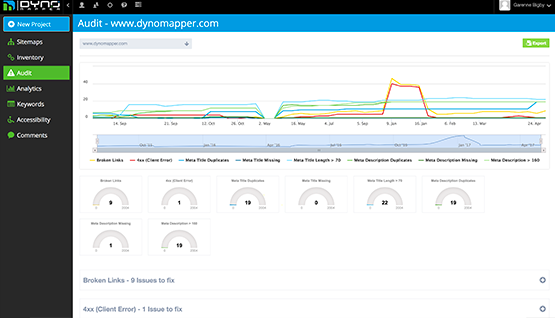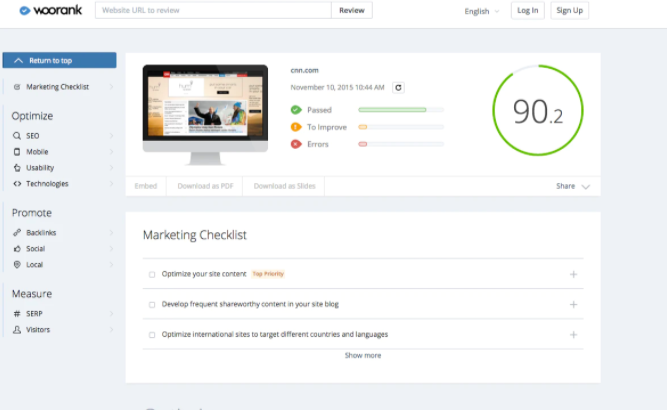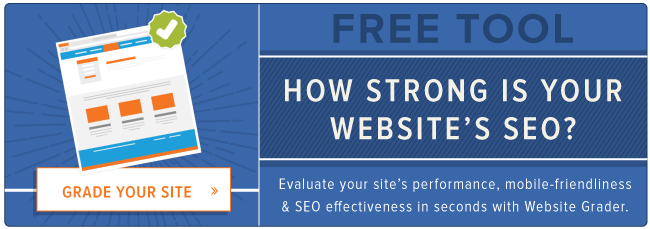Have you ever heard people refer to themselves as “Apple people,” “Nike people,” or “Trader Joe’s” people?
This is what brand awareness can do for a brand: embed itself into consumer lifestyles and purchase habits so that they don’t have to think twice before becoming a customer — time and time again.
This guide will help you better understand brand awareness, establish it among your audience, and build campaigns that allow it to continually grow and change with your business. Let’s dive in.
Brand awareness might seem like a vague concept, and in truth, it is. For those marketers and business owners out there who like to gauge success with neat and tidy numbers, brand awareness will likely ruffle your feathers.
But just because it isn’t a metric that can be perfectly determined doesn’t mean it doesn’t carry value. Brand awareness is incredibly important for business success and overall marketing goals. Here’s why.
Why is brand awareness important?
Brand awareness fosters trust.
In a world where consumers rely on extensive research and others’ opinions before making a purchase, brand trust is everything. Once a consumer bonds to your brand, they’re more likely to make repeat purchases with little to no forethought — which then bridges the gap between trust and loyalty.
Brand awareness establishes that brand trust. When you put a proverbial face to your brand name, consumers can trust easier. Brand awareness efforts give your brand a personality and outlet to be sincere, receive feedback, and tell a story. These are all ways that we, as humans, build trust with one another. The human/brand relationship isn’t any different.
Brand awareness creates association.
When you’ve had a paper cut, I bet you’ve put on a Band-Aid. When you had a pressing question, I’m sure you’ve Googled it. When you needed to make a few copies, I’m guessing that you Xeroxed them. And when you’ve packed for a nice picnic, I’m willing to bet you grabbed a Coke to drink.
Am I correct? Most likely. But ... notice how the some of the words above are capitalized. These are brands, not nouns or verbs.
Speaking in brand-less terms, Band-Aid should be referred to as bandage, Google as a search engine, and Xerox as a copier. But it’s more fun to refer to the brand itself, even if we aren’t using their specific product.
That’s what brand awareness does. It associates actions and products with particular brands, subconsciously encouraging us to replace common words with branded terms. And before you know it, simple paper cuts or picnics are doing the marketing for us.
Brand awareness builds brand equity.
Brand equity describes a brand’s value, which is determined by consumer experiences with and overall perception of the brand. Positive experiences and perception equal positive brand equity, and the same goes for negative notions.
Here are a few valuable things that come from positive brand equity:
- Higher prices due to higher perceived value
- A higher stock price
- The ability to expand business through product or service line extensions
- Greater social impact due to brand name value
How does a brand establish (and increase) brand equity? By building brand awareness and consistently promoting positive experiences with the brand. Brand awareness is the foundation of brand equity.
Once a consumer is aware of a brand, they start to recognize it without assistance, seek it out to make a purchase, begin to prefer it over other similar brands, and establish a loyalty that not only spurs on other purchases but also inspires recommendations to family and friends.
That is why brand awareness is so important. It establishes trust with your customers, creates positive associations, and builds invaluable brand equity that allows your brand to become a household name and consumer staple.
Brand awareness among your audience and the general public doesn’t happen overnight. It also doesn’t happen from a simple advertisement or marketing campaign.
Strong brand awareness is a result of multiple simultaneous efforts that extend beyond trying to get paying customers.
If you expect to raise awareness of your brand by running a few product advertisements on Facebook, you won’t get very far. Not only will the consumer be focused on the product (not the brand), but the ad will also lack impact beyond a simple sale.
Here are some ways to establish a solid brand awareness foundation and make a lasting impact with your audience:
1. Be a person, not a company.
When you get to know a new friend, what do you like to discover about them? I like to learn about hobbies, passions, likes and dislikes, and more. I also pay attention to how they speak, what they like to talk about, and what stuff gets them excited.
These are the traits your brand should determine and promote about itself. To leave an impact with your audience, you’ve got to define yourself as more than a company that sells stuff. How else would you define yourself? What words would you use if you had to introduce your brand to a new friend?
2. Socialize.
Introvert or extrovert, outgoing or quiet, all humans benefit from social contact and spending time with one another. It’s how we stay connected, learn new things, and become known by others.
The same goes for your brand. If you only attempt to connect with others when trying to make a sale or get support, you won’t be known as anything beyond a business with a singular intention (and the same goes for a person).
To raise awareness of your brand, you’ve got to be social. Post on social media about things unrelated to your product or services. Interact with your audience by asking questions, commenting on posts, or retweeting or sharing content you like. Treat your social accounts as if you were a person trying to make friends, not a business trying to make money.
Research shows that over 50% of brand reputation comes from online sociability. Being social leads to greater awareness and simply being known.
3. Tell a narrative.
Storytelling is an incredibly powerful marketing tactic, whether you’re marketing products or promoting your brand. Why? Because it gives something real for your audience to latch onto.
Crafting a narrative around your brand humanizes it and gives it depth. And weaving this said narrative into your marketing inherently markets your brand alongside your products or services.
What should your narrative be about? Anything, as long as it’s true. It can be the narrative of your founder, the tale of how your business had its first product idea, or the little-engine-that-could story of how your small business made it in this big world.
People like hearing stories about each other. Authenticity is impactful, and it can lead to a big boost in brand awareness.
4. Make sharing easy.
Whatever your industry, product offering, or marketing strategies, make it easy for your audience to share your content. This could be blog posts, sponsored content, videos, social media posts, or product pages. It doesn’t matter what it is, as long as it’s shareable.
Word-of-mouth marketing is the most effective way to establish trust and familiarity among customers. If someone sees that a friend or family member is recommending a product or service, they’ll take notice of that product … and brand. Is this a brand worth exploring? Do they have other great products I can rely on? What are their social accounts like, and what do they talk about?
If you make it easy to post about your stuff, consumers will raise brand awareness for you by simply clicking “Share”.
Brand awareness is about impact.
It’s about interacting with your audience in ways that don’t only ask for money, participation, or loyalty.
Imagine if you met a new person who wanted to be your friend. If they asked for any of the above, you’d probably laugh and walk away, right? Not only is that a shallow approach to friendship, but it also leaves no lasting impact on you.
The same goes for establishing and building brand awareness among your audience.
You already know how to start building your brand awareness from the ground up. Now, it’s time to put together a simple yet powerful brand awareness strategy that will keep the flywheel turning.
1. Guest blog on other niche websites.
Guest blogging is one of the best ways to increase brand awareness with minimal effort. You can take advantage of the traffic that’s already arriving at another website to get more eyes on your brand while offering helpful and relevant content.
In other words, you’re not just pushing out your product on people who aren’t ready to buy, but rather writing in your brand voice and presenting yourself as human first, company second. Another great alternative to guest blogging would be publishing sponsored content on niche websites.
2. Try co-marketing.
Co-marketing is an excellent way to build brand awareness — not only because you’d be taking advantage of another brand’s audience but because it can highlight who you are and what you offer in the marketplace.
For instance, if your company sells dog leashes and toys, you could potentially partner with a dog walking app. The campaign itself could appear in any number of ways: You could create a shared offer (“download the app and get one free leash”) or host an Instagram live together. No matter what, partnering up with another brand could help you double and even triple your reach.
3. Advertise everywhere.
I know, I know: Advertising many not build brand awareness so much as it builds product awareness, but still — it’s one of the best tools you can use to get people to find out about your brand in a low-touch, unobtrusive way.
Consider Grammarly. It feels like just a few years ago, no one knew about Grammarly. Now it’s one of those brands that you automatically think of when you consider online proofreading software. That’s because they’ve launched robust social, video, and display advertising campaigns that appear nearly everywhere.
You might consider starting with online advertising, which includes paid social media and PPC. If you’re interested in truly appearing everywhere and launching more sophisticated campaigns at a mass scale, you can launch programmatic advertising campaigns.
4. Hire a face or create a mascot for the company.
This may not be doable for smaller companies, but if you do have the budget, consider hiring an actor or spokesperson to represent the company. What do you first think of when you think of Progressive? Flo, who’s even been termed “Progressive girl” for her fun and friendly personality.
This allows you to not only humanize your brand, as mentioned in the previous section, but give a sense of the friendly and knowledgeable service customers can expect to receive.
You don’t have to use a person, either. GEICO is a great example of this. The moment you see that friendly lizard, you know it’s GEICO. Creating an animated mascot may be a cost-efficient but equally effective way to give a face to your brand.
5. Choose an image or symbol that represents you.
Nike is not even Nike anymore. It’s a check mark. The moment you see that check mark, you know it’s Nike. Or how about McDonald’s yello “M”? Or Apple’s bitten apple?
I’m not just talking about a logo, either, though it can certainly be part of your logo. But work with your branding team or a freelance graphic designer to create a symbol that you ubiquitously use in your marketing, advertising, and organic campaigns. You might also consider taking a note from Apple, McDonald’s, and Nike, and incorporating the symbol into your product packaging and design.
6. Create a short, catchy slogan.
Extending the Nike example, you think of the brand immediately when you hear “Just do it.” Creating a short motto or slogan is a cornerstone of a strong brand awareness strategy and is an easy and simple way to increase brand awareness.
It’s definitely tough — imagine condensing everything you’re about in one short sentence. It must explain how you’re different, what you offer, and why customers should choose you. Consider HubSpot’s tagline, “Helping millions grow better.” In four simple words, you understand why our product should be your choice when consider marketing automation tools.
Learn how to write an effective business slogan with this free guide.
Your brand awareness is now effectively off the ground, and people talk about you without needing to see an ad.
What about expanding your established brand awareness and building on that strong foundation? What can you do as a brand to campaign for awareness and constantly increase it?
Here are a few campaign ideas to boost your brand awareness beyond your initial strategy.
1. Offer freemium.
Freemium is a business model that offers a basic product or product line for free, only charging for any products deemed premium or enterprise-level. It’s a popular pricing strategy for software companies, like HubSpot and Trello.
Offering a freemium option allows customers to get a taste of your brand and product before making a purchase. It’s a try-before-you-buy opportunity that can, technically, last forever (as opposed to a free trial period that some companies choose).
It’s common to offer a freemium option with the condition that the brand’s watermark will be shown on any public-facing parts of the product or service. This makes freemium a win-win situation: The consumer gets the product for free, and the brand gets free advertising when consumers use it.
Typeform is another great example of this. Typeform offers a freemium option of its survey software, but customers must include a thank-you page that features the Typeform logo and message.
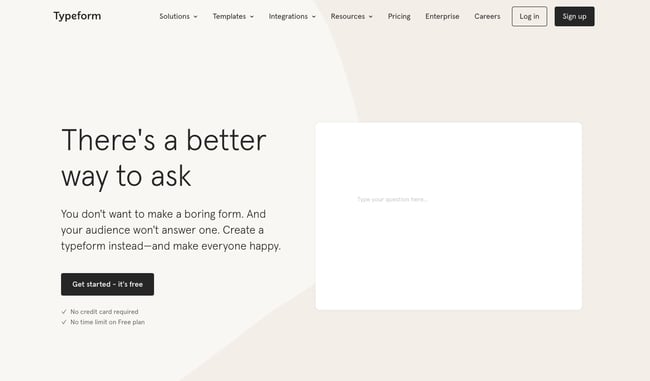 Depending on your type of business and product offer, Freemium may be the best way to raise awareness of your brand among your audience.
Depending on your type of business and product offer, Freemium may be the best way to raise awareness of your brand among your audience.
2. Create free content.
Nowadays, creating content is easier than ever … which is a good thing because today’s consumers turn to the internet for any and all questions, concerns, and DIY projects.
Content is a fun way to raise awareness of your brand because it’s the easiest way to show personality and share opinions and positioning on issues — two major components that personify and humanize your brand.
Content doesn’t have to be in written form, either. You can also create videos, infographics, podcasts (which we’ll cover below), and more. Sure, written content like blogs and downloadable guides are arguably the easiest, but they’re definitely not the only option.
Content doesn’t have to live on just your website, either. Guest posting and sponsored content provide opportunities to get in front of new audiences and diversify the type of content you create.
If your brand isn’t creating content, you might be missing out on some major brand awareness opportunities. Content provides an amazing way to authentically connect with your audience while getting your brand name in front of people.
3. Sponsor events.
How many festivals, concerts, fairs, and exhibitions have you attended? These types of events are typically not possible without the help of brand sponsorships. (Take a look at a t-shirt, koozie, or string backpack you likely grabbed from the event. See any brand names?)
Sponsoring events is a surefire way to get your brand in front of hundreds, thousands, or millions of people that likely fall into your target audience. From banners to flyers to water bottles, your brand name will be everywhere if you sponsor an event.
Sponsoring an event also allows you to pin your brand name on an event that matches your personality, interests, and passions, meaning consumers will then associate your brand with that event and its aesthetic and character. It can also gelp your company build brand awareness among highly specialized and qualified audiences. Professionals don’t attend events just for fun. They attend to learn the latest developments in the industry.
It’s more than just being a booth in a sea of booths. By being a consistent event sponsor, you’ll cement yourself in attendees’ minds as a leader in the field. They key is to be consistent in your sponsorship.
Consider Red Bull. Red Bull is an energy drink, and without any brand awareness efforts, we’d simply consider it an energy drink. But, thankfully, Red Bull took their marketing to the extreme — literally — by consistently sponsoring extreme sporting events like cliff diving and motocross. They also sponsor athletes. Now, we inherently associate Red Bull with daring and adventurous … and believe that, if we drink it, we can be the same.

4. Give your brand a personality.
Treating your brand as a person and defining your narrative are the first steps to giving your brand a personality. The next step would be infusing this personality into your marketing efforts.
When you market your products and services with personality, you can’t help but boost your brand awareness because your brand will shine right through. Sure, your consumers will take note of the pants or pasta you’re marketing, but they’ll also experience your personality through your advertising.
This is a great strategy when mixing your traditional marketing campaigns with brand awareness campaigns. They don’t always have to be one in the same, but they definitely can be.
Consider Old Spice. (Did you just picture the man on the horse? I did.) Their advertisements for their hygiene products are overflowing with personality and humor, and they still mention their products throughout. The advertisement not only makes an impact on its viewers, but a mere mention of the “Old Spice man” also sends consumers back to YouTube to watch the commercial … and to the store to buy some deodorant.
5. Produce a podcast.
More than one-third of Americans 12 and older listen to podcasts regularly. There’s no doubt podcasts play an important role in our lives … and marketing efforts.
Podcasts used to be a complicated process, only created by those with a studio and fancy microphone. Now, it’s easier than ever to create and release a podcast, and doing so can do wonders for your brand awareness efforts.
Why? Because podcasts, like written or visual content, provide a way to connect with your audience authentically. Instead of blatantly promoting your product or service (which we’ve agreed isn’t the best way to go about boosting brand awareness), podcasts give you the opportunity to educate, inform, entertain, or advise your audience and build trust by doing so.
Here are some examples of great podcasts produced by brands you know and love:
See how these brands have chosen podcast topics that relate to their 1) overall brand message and 2) products or services? Doing this helps them relate the podcast back to their brand and continue to raise awareness, too.
Building and growing brand awareness is a never-ending process, just as maintaining a friendship or relationship never really ends.
Boosting your brand awareness through campaigns gives you a chance to dabble in marketing and advertising opportunities you’d otherwise not invest in — meaning new, powerful ways to connect with your audience.
How to Measure Brand Awareness
How do you know if your brand awareness efforts are working? How do you know if you need to change direction, top the competition, or fix a crisis? Just like any other marketing metric, you measure it.
Wait … I thought you said brand awareness couldn’t be measured!
Aha! You’ve been listening. I appreciate that.
You’re right — brand awareness can’t be measured in the traditional sense. But, you can still review activities and metrics that’ll help you gauge where your brand stands in terms of popularity and consumer awareness.
Here are a few ways to gauge your brand awareness and learn where you can tweak your efforts:
Quantitative Brand Awareness Measures
These numbers can help you paint the overall picture of your brand awareness. To measure quantitatively, check out these metrics:
- Direct traffic. Firstly, direct traffic is the result of people intentionally typing in your URL and visiting your website. Your direct traffic number will tell you how much your marketing is prompting people to visit your website. This is an important metric, as many consumers today discover brands through social media, advertisements, or by typing in keywords related to your brand or product. When consumers go directly to your site, it means they were aware of your brand beforehand.
- Site traffic numbers. This number just reflects overall site traffic, which will tell you how much of the general internet population is checking out your content and spending time with your brand. It won’t quite tell you where people came from, but that doesn’t matter, because they’re aware of your brand enough to check it out.
- Social engagement. Engagement can refer to followers, likes, retweets, comments, and more. It’s a reflection of how many people are aware of your brand and socialize with it, as well as how impactful your content is. For instance, sites like Sparktoro can give you a specific score for your Twitter impact.
Qualitative Brand Awareness Measures
This step is where your brand awareness “score” gets a little murky. But these tactics can still help you gauge who and how many people are aware of your brand. To measure qualitatively, try:
- Searching Google and setting up Google Alerts. Doing this gets you up to speed with how your brand is being talked about online. It will alert you to any news or mentions by third-party press. As your brand grows, its internet real estate will expand beyond your website, so keep an eye on that.
- Social listening. Social listening is monitoring social media management tools for organic mentions and engagement. Who’s tagging your brand, mentioning it in comments, or using your hashtag in their posts? These tools can help you discover that. And the more your audience is discussing your brand on social media, the more they’re aware of it.
- Running brand awareness surveys. This process involves getting direct feedback from your customers and audience and can be incredibly helpful with not only understanding who knows of your brand but also what they think of it. You can release surveys through SurveyMonkey or Typeform and share them on social media or directly with your customers. This guide will help you create and promote them.
These quantitative and qualitative metrics will help you understand your brand awareness among your audience and the general public. It’ll never be a perfect number, but keeping your pulse on this measure will help influence campaigns and stay connected to your audience. Regardless of how you gauge brand awareness for your company, avoid these common mistakes when measuring brand awareness.
Brand Awareness Examples
Not sure what a brand awareness campaign can look like? Let’s take a look at some top examples.
 HubFans is a brand awareness campaign that rewards avid and knowledgeable HubSpot users for spreading their knowledge about the CRM platform. It’s a brilliant campaign because awareness is built not by the HubSpot brand, but by HubSpot customers. That automatically makes the brand seem more approachable and human.
HubFans is a brand awareness campaign that rewards avid and knowledgeable HubSpot users for spreading their knowledge about the CRM platform. It’s a brilliant campaign because awareness is built not by the HubSpot brand, but by HubSpot customers. That automatically makes the brand seem more approachable and human.
In the same way, you can get your customers to advocate for you by rewarding them if they share knowledge about your product. This will make it easier to build an army of brand evangelists who will effortlessly scale your brand awareness efforts.
 We all know of companies that release new gadgets and features to keep their product lines up-to-date. But none come to Apple’s level of famousness, and that’s because Apple hosts an entire event dedicated to announcing its new releases.
We all know of companies that release new gadgets and features to keep their product lines up-to-date. But none come to Apple’s level of famousness, and that’s because Apple hosts an entire event dedicated to announcing its new releases.
Even though the updates to the actual products are minimal, Apple has “hyped up” the event to such a degree that you know automatically to watch for the brand’s new developments. That keeps the brand at the forefront of customers’ minds when they're considering a new tech gadget.
 Having an admirable mission at the core of your company is a great move for building brand awareness — especially if you enable your customers to share resources that can help others.
Having an admirable mission at the core of your company is a great move for building brand awareness — especially if you enable your customers to share resources that can help others.
That’s what Rare Beauty did with its Mental Health 101 initiative. It built a kit that people could share on their social media sites to build awareness about the importance of mental health. By sharing the brand’s kit, users are also sharing the brand itself, which is an excellent way to build brand awareness.
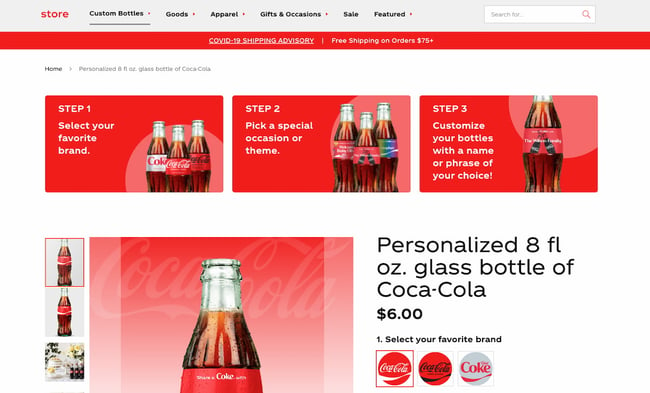 Coca-Cola doesn’t need more brand awareness, and that’s because it has built it so effectively over time that it has reached iconic status. One such example is its “Share a Coke” campaign, where you can find a Coke bottle with your name in store. Or personalize one with a phrase.
Coca-Cola doesn’t need more brand awareness, and that’s because it has built it so effectively over time that it has reached iconic status. One such example is its “Share a Coke” campaign, where you can find a Coke bottle with your name in store. Or personalize one with a phrase.
This is a brilliant brand awareness move that capitalizes on customers’ love of personalization, and with it, Coca-Cola ensures it remains an unshakable American classic. This example shows how far personalization will get you in your brand awareness campaign, so try to personalize whenever possible. If your product isn’t disposable, consider giving customers the option to add their name.
 If your product does something incredible — such as staying put even under a stream of water — consider filming one or more videos about it. That’s what Beauty Bakerie did with its now-famous Matte Lip Whip products.
If your product does something incredible — such as staying put even under a stream of water — consider filming one or more videos about it. That’s what Beauty Bakerie did with its now-famous Matte Lip Whip products.
I remember when my Instagram feed used to filled with videos of people putting Matte Lip Whip swatches under water and washing them with soap. It was so incredible that I couldn’t help but look at the brand. Behold, I was now aware of Beauty Bakerie, and have been following them ever since.
Show off something about your product that might just shock your audience into learning more about you. It’s guaranteed to work like it did for Beauty Bakerie.
Over to You
Brand awareness is a powerful (albeit vague) concept that can have a major impact on your marketing efforts, consumer perception, and revenue.
Follow these techniques for establishing and building awareness for your brand, and you’ll find yourself with a loyal audience that recognizes your brand among competitors, chooses your products time and time again, and recommends their friends and family do the same.
Editor's note: This post was originally published in October 2017 and has been updated for comprehensiveness.

 The Ultimate Guide to Brand Awareness
The Ultimate Guide to Brand Awareness was originally posted by
Local Sign Company Irvine, Ca. https://goo.gl/4NmUQV https://goo.gl/bQ1zHR http://www.pearltrees.com/anaheimsigns

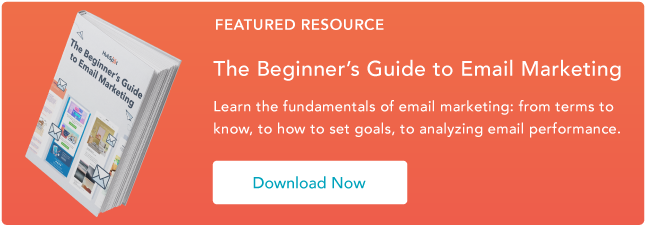
![New Data: Instagram Engagement Report [2021 Version]](https://no-cache.hubspot.com/cta/default/53/9294dd33-9827-4b39-8fc2-b7fbece7fdb9.png)
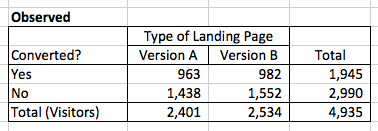

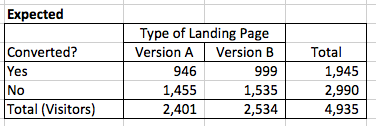
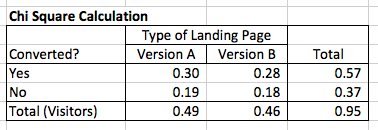

![→ Click here to download leadership lessons from HubSpot founder, Dharmesh Shah [Free Guide].](https://no-cache.hubspot.com/cta/default/53/4e634041-e1ce-4a85-8e65-aea12fc10b84.png)
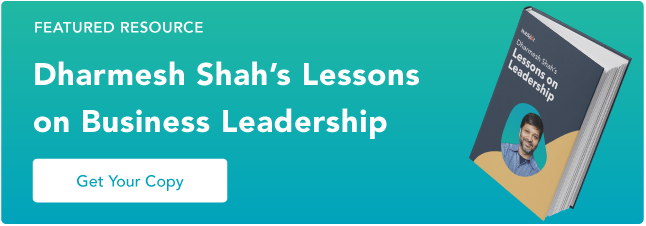

 Depending on your type of business and product offer, Freemium may be the best way to raise awareness of your brand among your audience.
Depending on your type of business and product offer, Freemium may be the best way to raise awareness of your brand among your audience.
 HubFans is a brand awareness campaign that rewards avid and knowledgeable HubSpot users for spreading their knowledge about the CRM platform. It’s a brilliant campaign because awareness is built not by the HubSpot brand, but by HubSpot customers. That automatically makes the brand seem more approachable and human.
HubFans is a brand awareness campaign that rewards avid and knowledgeable HubSpot users for spreading their knowledge about the CRM platform. It’s a brilliant campaign because awareness is built not by the HubSpot brand, but by HubSpot customers. That automatically makes the brand seem more approachable and human. We all know of companies that release new gadgets and features to keep their product lines up-to-date. But none come to Apple’s level of famousness, and that’s because Apple hosts an entire event dedicated to announcing its new releases.
We all know of companies that release new gadgets and features to keep their product lines up-to-date. But none come to Apple’s level of famousness, and that’s because Apple hosts an entire event dedicated to announcing its new releases. Having an admirable mission at the core of your company is a great move for building brand awareness — especially if you enable your customers to share resources that can help others.
Having an admirable mission at the core of your company is a great move for building brand awareness — especially if you enable your customers to share resources that can help others. Coca-Cola doesn’t need more brand awareness, and that’s because it has built it so effectively over time that it has reached iconic status. One such example is its “Share a Coke” campaign, where you can find a Coke bottle with your name in store. Or personalize one with a phrase.
Coca-Cola doesn’t need more brand awareness, and that’s because it has built it so effectively over time that it has reached iconic status. One such example is its “Share a Coke” campaign, where you can find a Coke bottle with your name in store. Or personalize one with a phrase. If your product does something incredible — such as staying put even under a stream of water — consider filming one or more videos about it. That’s what Beauty Bakerie did with its now-famous Matte Lip Whip products.
If your product does something incredible — such as staying put even under a stream of water — consider filming one or more videos about it. That’s what Beauty Bakerie did with its now-famous Matte Lip Whip products.

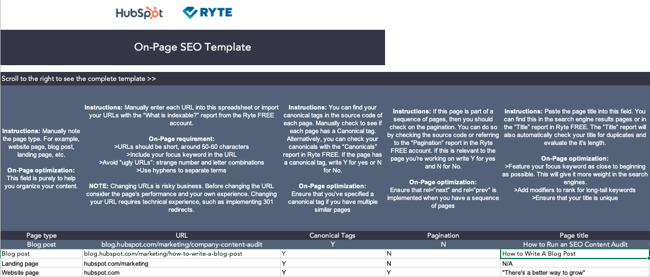
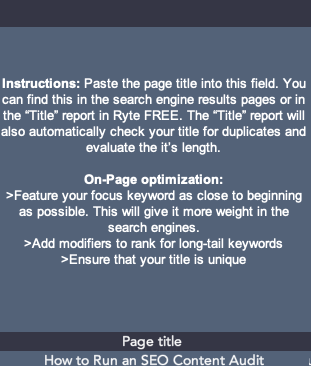 This section makes sure you'll have keywords in your page title, boosting SERP rank. Similarly, in the next section, you'll define the goal of each page and the focus keywords of that page.
This section makes sure you'll have keywords in your page title, boosting SERP rank. Similarly, in the next section, you'll define the goal of each page and the focus keywords of that page.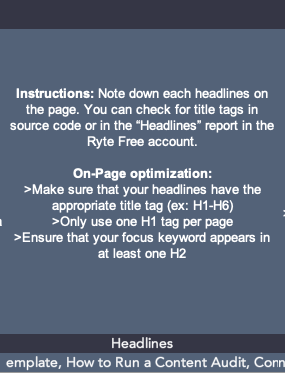
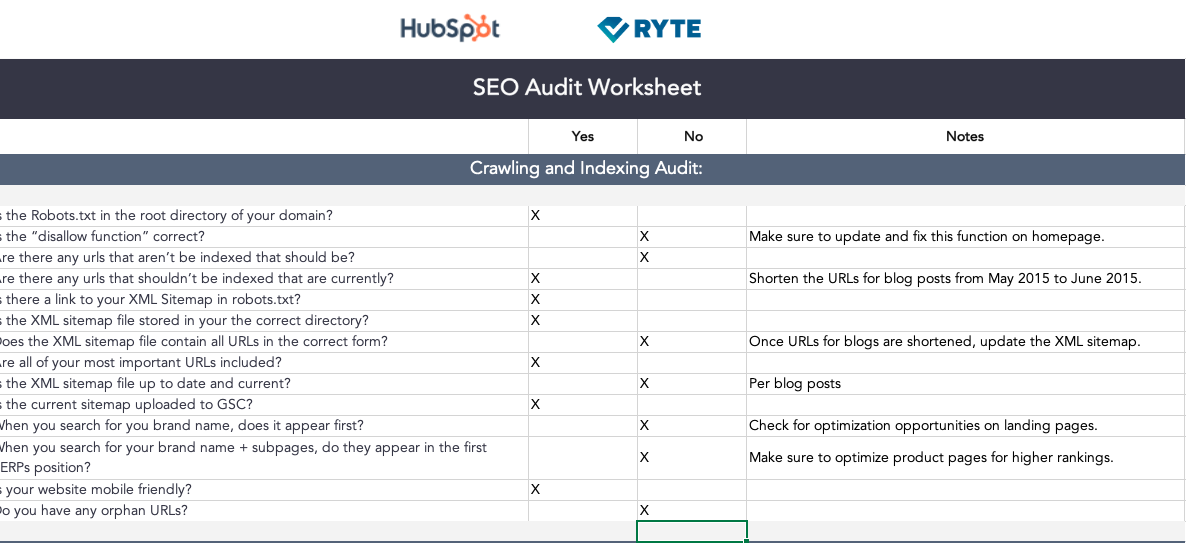 For example, when you go through the worksheet, you can expect to include information about the On-Page elements of your website. Still, you’ll also be checking for crawling and indexing, ranking factors, the content and link structure, status codes, coding, and internalization.
For example, when you go through the worksheet, you can expect to include information about the On-Page elements of your website. Still, you’ll also be checking for crawling and indexing, ranking factors, the content and link structure, status codes, coding, and internalization.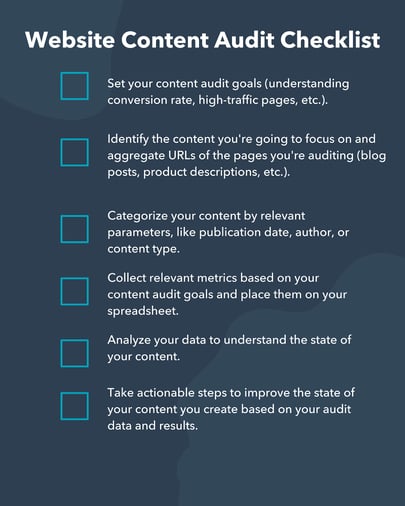

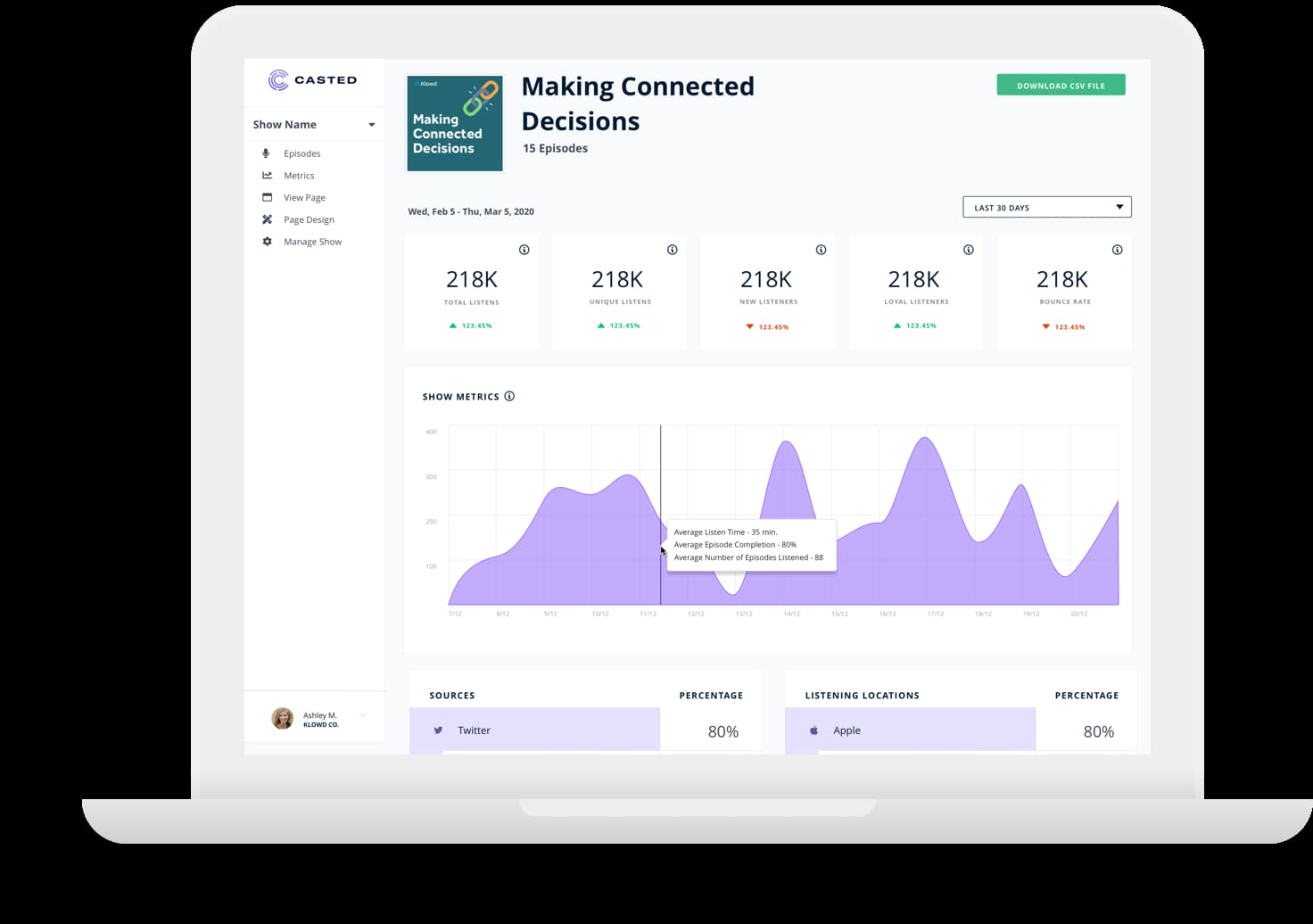
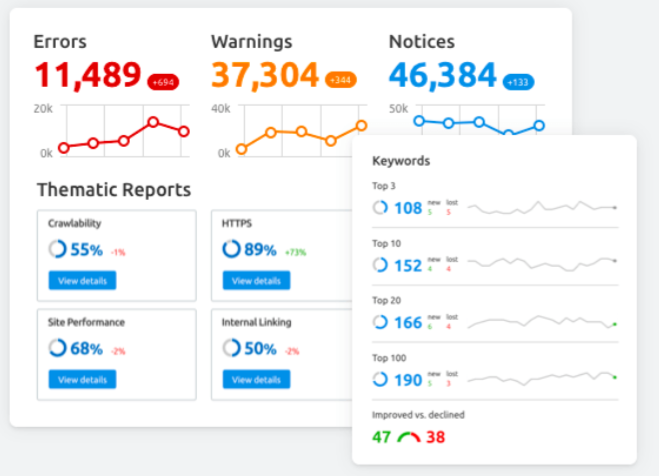
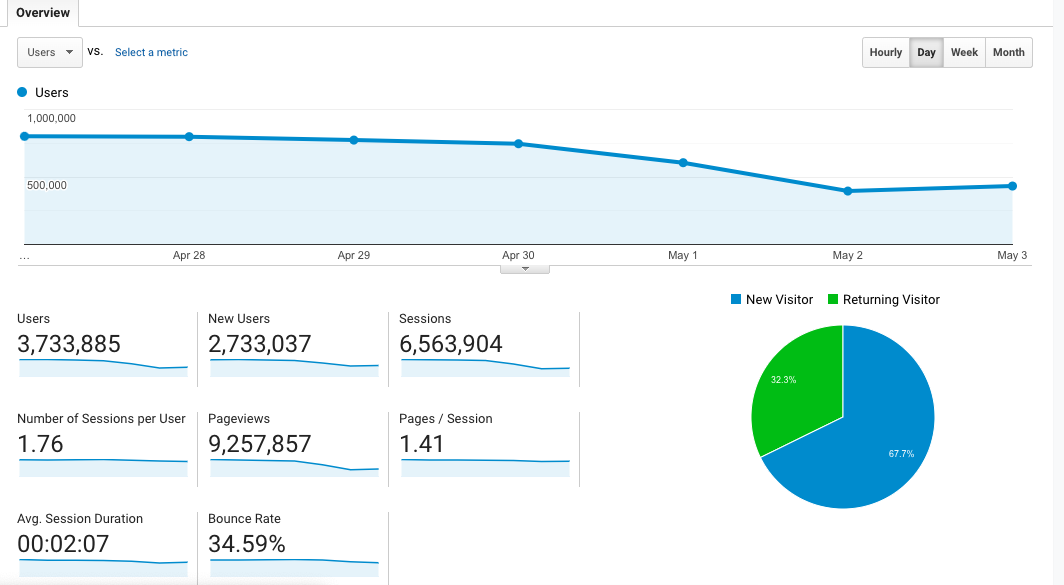 It gives you data about the amount of time visitors are seeing on webpages, the most popular webpages, and different patterns seen in your visitors. One of these patterns could be the most popular blog post in the US from visitors aged 18-24.
It gives you data about the amount of time visitors are seeing on webpages, the most popular webpages, and different patterns seen in your visitors. One of these patterns could be the most popular blog post in the US from visitors aged 18-24.